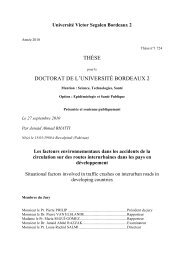Télécharger le texte intégral
Télécharger le texte intégral
Télécharger le texte intégral
Create successful ePaper yourself
Turn your PDF publications into a flip-book with our unique Google optimized e-Paper software.
Verbal short-term memory measuresWe compared verbal short-term memory spans between the two groups of patients. Mean forward and backward verbal spanof men and women are reported Tab<strong>le</strong> 1. No differences were found between the groups neither in the forward verbal span task(U ¼ 161.0, p ¼ .30) nor in the backward span task (U ¼ 173.0, p ¼ .48).Passive storage and active manipulation of visuospatial informationFinally, we compared visuospatial performances between the ma<strong>le</strong> and fema<strong>le</strong> AD patients in the two tasks involvingpassive storage, that is, forward span of Corsi block-tapping and Vecchi’s matrix memory tasks, and in the two tasks involvingactive manipulation, that is, backward span of Corsi block-tapping and Vecchi’s mental pathway tasks. Mean performancesof the groups are reported in Tab<strong>le</strong> 1. Regarding passive storage, no differences were found between the groups forforward Corsi blocks task (U ¼ 164.0, p ¼ .34) and for Vecchi’s matrix memory task (U ¼ 178.0, p ¼ .57). In contrast, thestatistical analyses showed significant differences in the two tasks involving active manipulation. The fema<strong>le</strong> patients performedsignificantly lower than ma<strong>le</strong> patients in the backward Corsi blocks task (U ¼ 127.0, p , .05) as well as inVecchi’s pathway task (U ¼ 69.5, p , .001).DiscussionX. Mil<strong>le</strong>t et al. / Archives of Clinical Neuropsychology 24 (2009) 783–789 787Previous results have shown that AD patients were more impaired in visuospatial tasks requiring active processing than inthose involving passive storage (Vecchi et al., 1998b). Since men are assumed to be advantaged in visuospatial tasks requiringactive processing, this study was undertaken to determine whether gender influence on visuospatial performances persists inpatients who have developed AD. Our results showed that ma<strong>le</strong> AD patients performed significantly better than women in tasksrequiring active visuospatial manipulation. On the contrary, the two groups of patients exhibited equiva<strong>le</strong>nt performances in themore passive visuospatial memory tasks. Therefore, gender differences in visuospatial processing in AD evidenced in our studywere limited to the tasks yielding dynamic transformation of the material. Importantly, the lower performances of fema<strong>le</strong> participantscould not be related to a difference in dementia severity or a difference in basic visual identification abilities. Indeed,dementia severity assessed by both MMSE and MDRS as well as the visual discrimination abilities were similar between thetwo groups of ma<strong>le</strong> and fema<strong>le</strong> AD patients. An interesting finding is that the two groups exhibited equiva<strong>le</strong>nt performances inthe backward verbal span task. Thus, the advantage of ma<strong>le</strong> over fema<strong>le</strong> AD patients in active manipulation processing maynot be generalizab<strong>le</strong> to all tasks modalities but would rather be limited to visuospatial information processing. Our studygives support to the assumption that despite AD, men still present a greater ability than women to operate manipulation onvisuospatial information and to use this dynamically changing information to guide their performance.The tasks se<strong>le</strong>cted to assess passive storage were the forward span of Corsi blocks task and Vecchi’s matrix memory task,whereas the tasks se<strong>le</strong>cted to assess active manipulation were the backward span of Corsi blocks task and Vecchi’s pathwaytask. Regarding the forward span of the Corsi blocks task, despite its spatio-sequential component (Della Sala, Gray, Badde<strong>le</strong>y,Allamano, & Wilson, 1999), it is generally considered as a more passive task than the backward span task (Vecchi & Cornoldi,1999). Vecchi’s matrix memory task is also assumed to yield passive storage of visuospatial information because the locationof the target squares has to be remembered in the same configuration as that presented previously. The only two tasks yieldingsignificant differences between men and women were the tasks involving active processing in visuospatial working memory.Since attentional resources are being increased with the necessity to reproduce the sequences in reverse order in the Corsiblock-tapping task (Vandierendonck, Kemps, Fastame, & Szma<strong>le</strong>c, 2004), the backward span task is assumed to require ahigher degree of active manipulation than the forward tapping condition. In the same vein, Vecchi’s pathway task has beenchosen to assess active manipulation processes since generating the mental image of a dot displacing through a pathwayrequires participants to continuously create new images. A possib<strong>le</strong> limitation is that some subjects could have used averbal strategy to accurately execute the task. In particular, when the processing requirement is substantially increased, astrategy could consist in recoding the pattern of displacements into a verbal format. However, even though the existenceof verbal strategies could not be totally excluded, Vecchi and Girelli (1998a) have shown that the ro<strong>le</strong> of such strategies inexecuting the pathways is limited.Different hypotheses can be advanced to explain gender-related performances in visuospatial tasks. First, ma<strong>le</strong> advantage intasks requiring maintenance and manipulation of visuospatial information could ref<strong>le</strong>ct the use of different cognitive strategiesin men and women. Gender differences in the generation of mental pathways could be related to men’ greater propensity toconceive the overall shape of the pathway, whereas women may preferentially use analytic part-by-part strategies. In amental rotation task, Heil and Jansen-Osmann (2008) showed that men did not increase the time to perform the task with
















